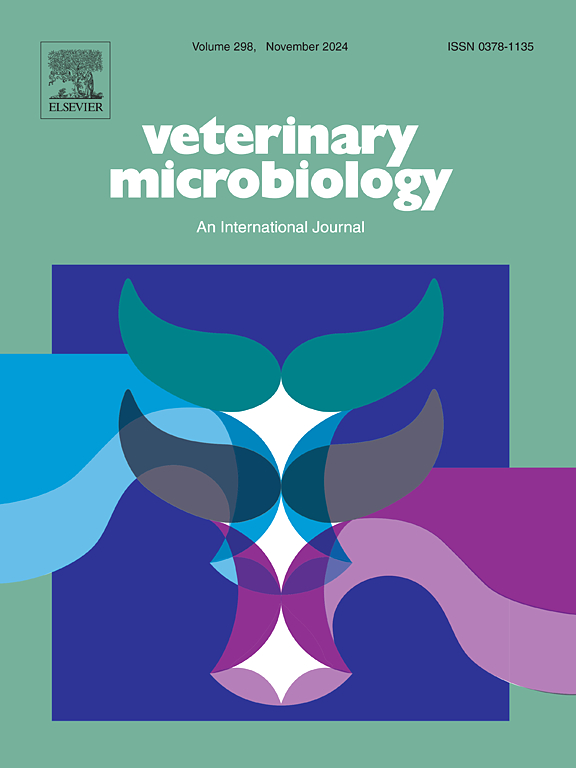The kinetics of gene expression related to innate and adaptive immunity in the lung and spleen following Newcastle disease virus (NDV) infection in vaccinated broiler chickens employing different vaccination regimes
IF 2.4
2区 农林科学
Q3 MICROBIOLOGY
引用次数: 0
Abstract
Newcastle disease virus (NDV) classified as an avian paramyxovirus-1 poses a significant risk to the global poultry sector. This study explored the kinetics of the innate and adaptive immune responses in chickens exposed to virulent Newcastle Disease Virus (vNDV) genotype VII. A challenge experiment was carried out with both non-vaccinated and NDV-vaccinated chickens utilizing different vaccination strategies commonly used in the industry. The four groups of vaccinated birds were administered either two doses of live NDV vaccines, live vaccines boosted with an inactivated vaccine, the rHVT-NDV-IBDV vaccine alone, or the rHVT-NDV-IBDV vaccine in conjunction with a live vaccine booster. To assess seven cytokines linked to antiviral and proinflammatory innate responses quantitative real-time polymerase chain reaction (qRT-PCR) analyses were implemented. The analyses revealed robust innate immune responses in all cytokines measured in lung and spleen tissues of the group that received both live and inactivated vaccines. Notably these increases were found to correlate with the humoral immune response within that same group. Significant transcriptional activity in the lung and spleen tissues of non-vaccinated chickens at 24 hour post-infection (pi). The most significant upregulations were identified in toll-like receptor 7 (TLR7), TLR5, interleukin 6 (IL6), chicken interferon-alpha (chIFN-α), and myxovirus resistance protein 1 (Mx1), which later exhibited a regression. The administration of both live and inactivated vaccines has proven effective in restoring the suppression or inhibition of vNDV infection across a wide range of cytokines, including TLR7, TLR5, chIFN-α, Mx1, IL6, and MHC-1. Various vaccination strategies have been shown to either mitigate or prevent cytokine storms within 24 hour pi in the lungs, spleen, or both, in certain cytokines such as chIFN-α, Mx1, and IL6. Collectively these results suggest that different vaccination strategies modify the kinetics and pathophysiological responses associated with vNDV infection in chickens.
新城疫病毒(NDV)感染后不同接种方案下肉鸡肺和脾脏先天免疫和适应性免疫相关基因表达动力学
新城疫病毒(NDV)被归类为禽副粘病毒-1,对全球家禽业构成重大威胁。本研究探讨了暴露于毒性新城疫病毒(vNDV)基因型 VII 的鸡的先天性和适应性免疫反应动力学。利用行业中常用的不同疫苗接种策略,对未接种疫苗和接种了 NDV 疫苗的鸡进行了挑战实验。四组接种过疫苗的鸡分别接种了两剂 NDV 活疫苗、用灭活疫苗加强的活疫苗、单独接种 rHVT-NDV-IBDV 疫苗或 rHVT-NDV-IBDV 疫苗与活疫苗加强剂联合接种。为了评估与抗病毒和促炎先天反应相关的七种细胞因子,进行了定量实时聚合酶链反应(qRT-PCR)分析。分析结果显示,在接种活疫苗和灭活疫苗组的肺部和脾脏组织中测量的所有细胞因子都出现了强健的先天性免疫反应。值得注意的是,这些细胞因子的增加与该组的体液免疫反应相关。在感染后 24 小时(π),未接种疫苗的鸡的肺和脾组织中存在显著的转录活性。发现上调最明显的是收费样受体 7 (TLR7)、TLR5、白细胞介素 6 (IL6)、鸡干扰素-α (chIFN-α)和肌瘤病毒抗性蛋白 1 (Mx1),这些转录因子后来出现了回落。事实证明,接种活疫苗和灭活疫苗可有效抑制或抑制 vNDV 感染,包括 TLR7、TLR5、chIFN-α、Mx1、IL6 和 MHC-1 等多种细胞因子。在某些细胞因子(如 chIFN-α、Mx1 和 IL6)方面,各种疫苗接种策略已被证明可在 24 小时内减轻或防止肺、脾或两者中的细胞因子风暴。总之,这些结果表明,不同的疫苗接种策略会改变与鸡 vNDV 感染相关的动力学和病理生理反应。
本文章由计算机程序翻译,如有差异,请以英文原文为准。
求助全文
约1分钟内获得全文
求助全文
来源期刊

Veterinary microbiology
农林科学-兽医学
CiteScore
5.90
自引率
6.10%
发文量
221
审稿时长
52 days
期刊介绍:
Veterinary Microbiology is concerned with microbial (bacterial, fungal, viral) diseases of domesticated vertebrate animals (livestock, companion animals, fur-bearing animals, game, poultry, fish) that supply food, other useful products or companionship. In addition, Microbial diseases of wild animals living in captivity, or as members of the feral fauna will also be considered if the infections are of interest because of their interrelation with humans (zoonoses) and/or domestic animals. Studies of antimicrobial resistance are also included, provided that the results represent a substantial advance in knowledge. Authors are strongly encouraged to read - prior to submission - the Editorials (''Scope or cope'' and ''Scope or cope II'') published previously in the journal. The Editors reserve the right to suggest submission to another journal for those papers which they feel would be more appropriate for consideration by that journal.
Original research papers of high quality and novelty on aspects of control, host response, molecular biology, pathogenesis, prevention, and treatment of microbial diseases of animals are published. Papers dealing primarily with immunology, epidemiology, molecular biology and antiviral or microbial agents will only be considered if they demonstrate a clear impact on a disease. Papers focusing solely on diagnostic techniques (such as another PCR protocol or ELISA) will not be published - focus should be on a microorganism and not on a particular technique. Papers only reporting microbial sequences, transcriptomics data, or proteomics data will not be considered unless the results represent a substantial advance in knowledge.
Drug trial papers will be considered if they have general application or significance. Papers on the identification of microorganisms will also be considered, but detailed taxonomic studies do not fall within the scope of the journal. Case reports will not be published, unless they have general application or contain novel aspects. Papers of geographically limited interest, which repeat what had been established elsewhere will not be considered. The readership of the journal is global.
 求助内容:
求助内容: 应助结果提醒方式:
应助结果提醒方式:


